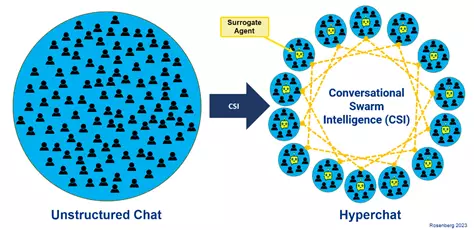In an era defined by rapid technological advancement, traditional methods of collaboration are being challenged. The potential for a large team of individuals to brainstorm, share insights, and generate solutions in real-time has never been more significant. Imagine a scenario where an assembly of 200 people can efficiently collaborate to harness collective intellect. Could that be possible? Thanks to developments in generative artificial intelligence, specifically conversational swarm intelligence, what once seemed far-fetched is now a tangible reality. This technology, heralded as hyperchat, offers an innovative method for extensive groups to communicate effectively and converge on optimized solutions.
The challenge with conventional group discussions is well-documented. Research indicates that productive dialogue typically flourishes in smaller groups, ideally consisting of four to seven participants. In such settings, individuals can express their thoughts freely, and responses can be exchanged fluidly. However, as groups grow, these dynamics shift dramatically. Communication becomes stuttered, and interactions may devolve into a cacophony of overlapping voices. Enter hyperchat: a solution designed to allow large groups to leverage their diversity and intelligence without the chaos of traditional formats.
Transformative Mechanisms of Hyperchat
So, how does hyperchat actualize its promise? The technology employs an ingenious strategy to break larger crowds into manageable subgroups. This allows for meaningful conversations without overwhelming participants. Each subgroup operates with a conversational surrogate—an AI agent that distills insights and disseminates them across the larger assembly. This enables streams of conversation to blend seamlessly, facilitating an expansive yet cohesive dialogue.
Consider what this means for brainstorming efforts. The potential for ideation skyrockets as participants can seamlessly build on insights derived from their counterparts. The boundaries once imposed by group size dissolve, permitting enhanced collective intelligence. This principle was recently put to the test by the research team at Unanimous AI, which assembled 50 sports enthusiasts to create a March Madness bracket utilizing the hyperchat platform known as Thinkscape.
Remarkably, this collective effort produced a bracket that performed in the 99th percentile on ESPN’s March Madness contest. This result not only highlights the efficacy of hyperchat but raises critical questions—what drives this increased performance? Is it simply the aggregation of opinions, or is there a deeper synergy at play?
Evidence of Enhanced Collective IQ
Hyperchat technology has garnered attention not just for its process but also for its results. A study conducted by researchers at Carnegie Mellon and Unanimous AI demonstrated that groups of 35 people using hyperchat surged in their performance on standard IQ tests. Participants who typically averaged an IQ of 100 scored an impressive effective IQ of 128 while engaging with the hyperchat platform. This leap showcases the astonishing capabilities of conversational swarm intelligence.
Moreover, a follow-up study focused on creative problem-solving underscored the advantages of hyperchat over conventional chat platforms. Participants engaged in brainstorming sessions reported feeling significantly more productive, engaged, and satisfied with their contributions. This spurred an increased sense of ownership over the emerging solutions, highlighting how hyperchat can redefine teamwork dynamics by establishing a deeper connection with the collaborative process.
AI-Enhanced Collaboration: Bridging the Human-Machine Divide
One of the most compelling features of hyperchat is its potential to synergistically connect human teams with AI agents. The introduction of contributor agents—AI agents that provide real-time factual content—enables a hybrid model of decision-making that balances human intuition with data-driven insights. The advantage of such collaboration is substantial; it allows for more informed decisions while keeping people firmly in control of the outcomes.
Empirical evidence sourced from various studies echoes the promise of this hybrid collective superintelligence. In a recent fantasy baseball study, a mixture of human participants and AI agents utilized hyperchat to build teams, achieving remarkable satisfaction rates among participants. An overwhelming 87% asserted that the hyperchat format significantly improved their decision-making capabilities.
In an age where organizational structures are often cumbersome, hyperchat presents a practical solution. It could potentially eradicate the bottlenecks that typically limit real-time deliberation and unleash the latent potential of collective intelligence within large organizations, such as Fortune 1000 companies that often have thousands of employees spread across functional teams.
As we stand on the cusp of a transformative shift in collaborative dynamics, hyperchat emerges as a game-changer in group intelligence. Its ability to amalgamate diverse perspectives into a coherent and productive dialogue represents more than just an evolution of team collaboration—it is a revolution. As organizations look to harness the power of collective intelligence, embracing technologies like hyperchat could be the key to unlocking unprecedented levels of creativity, innovation, and efficiency.


Leave a Reply